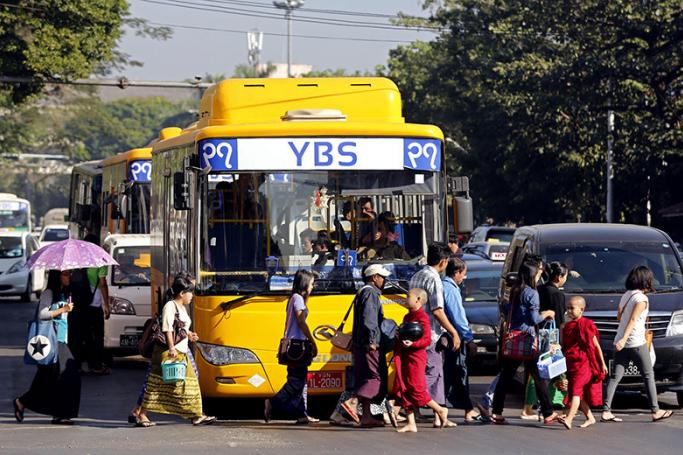Fatalities resulting from road accidents continue to be a daily occurrence in Myanmar. Last year alone, there were more than 16,000 accidents. Over 4,600 people died and left behind their loved ones - tragedies that could have been avoided. If this doesn’t strike as a wake-up call for more sustainable measures to address the situation, concrete facts and figures should.
According to the Ministry of Transportation, there were more than 6 million vehicles in Myanmar in 2016, and close to 84 percent of these new vehicle registered were motorcycles. While the prevalence of more vehicles on the road reflects the economic progress of Myanmar, this has also unfortunately led to an increase of statistics for road accidents.
In Southeast Asia, there are approximately 63,000 reported road traffic deaths each year. However, according to the World Health Organization (WHO), the reported numbers do not represent the real magnitude of the road safety problem in the region. It is estimated that the actual number of road traffic fatalities lies at around 117,000 per year, due to either inaccurate data or undocumented accidents. While Singapore has one of the fewest traffic-related deathsworldwide, Thailand has one of the most, second only to Libya.
Closer to home, Myanmar is ranked fourth highest in terms of the rate of traffic fatality, with an average of more than 20 deaths per 100,000 of the population. This means that roughly 13 people perished each day due to road traffic accidents. Regrettably, unsafe driver and rider behavior, poor road infrastructure and unpredictable weather conditions remain some of the principal causes for such devastating numbers.
While the Myanmar government has conducted numerous safety campaigns and initiatives to improve awareness amongst road users, we need to find sustainablesolutions for a problem that is claiming the lives of thousands of citizens and costing governments tremendous amounts of money every year.
For Bosch, every traffic-related death is one too many. As a supplier for mobility solutions, we believe that the most substantial impact the automotive industry can make is to produce safer vehicles equipped with modern safety systems such as Antilock Braking System (ABS) and Electronic Stability Control (ESC). With the behavior of road users as the main cause of close to 82 percent of road accidents in Myanmar, it is critical for active safety systems technology to be installed in all vehicles, regardless of vehicle type, make and model.
What is Antilock Braking System (ABS)?
The world’s first Antilock Braking System (ABS) for passenger cars dates back to1978. ABS is the commonplace technology in passenger cars that prevent the wheels from locking during an emergency braking scenario. This innovation allows the driver to maintain steering control and in most situations, shortens the braking distance without skidding, which saves lives. While ABS is a fairly common feature in most passenger cars today, what most road users are not aware of is that ABS technology for motorcycles has also long been in existence.
Introduced in 1995, motorcycle ABS significantly reduces the risk of falling, shortens the stopping distance, and therefore the risk of collision. Our research estimates that if every powered two-wheeler was equipped with ABS, around one in four of all motorcycle accidents in the ASEAN member countries could be prevented. Worldwide, an increasing number of countries such as the European Union countries, Japan, Taiwan, and India are mandating motorcycle ABS fornew vehicles.
Is your vehicle installed with Electronic Stability Control (ESC)?
Bosch improved ABS technology in 1995 by developing the world’s first ElectronicStability Control (ESC), also known as Electronic Stability Program (ESP®).
Using smart sensors, ESC compares 25 times per second whether a driver’s steering input matches the vehicle’s actual direction of travel. If the system detects discrepancy and identifies that the vehicle is likely to become unstable, ESC intervenes by reducing the engine torque in order to restore stability. If necessary, brakes to individual wheels are applied should the system sense that the vehicle is still in danger.
ESC in Europe alone has saved more than 8,500 lives and prevented more than a quarter of a million traffic accidents to date. If all vehicles are equipped with ESC, up to 80 percent of all skidding accidents can be prevented. This makesESC the most important vehicle safety system after the seat belt – more important even than the airbag. Today, 64 percent of all new passenger cars and light commercial vehicles worldwide are fitted with ESC.
While we continue to pursue wider adoption of such technologies amongst industry players, it is critical that the public and governments also take greater note of the life-saving potential of active safety technologies today, and to pursue clear steps towards their adoption. Only collectively can we help to make a difference to save lives.
About Andre de JongAndre de Jong is the Managing Director of Bosch in Cambodia, Laos and Myanmar, and holds overall responsibility of driving the Bosch businesses in the three countries.
You are viewing the old site.
Please update your bookmark to https://eng.mizzima.com.
Mizzima Weekly Magazine Issue...
14 December 2023
Spring Revolution Daily News f...
13 December 2023
New UK Burma sanctions welcome...
13 December 2023
Spring Revolution Daily News f...
12 December 2023
Spring Revolution Daily News f...
11 December 2023
Spring Revolution Daily News f...
08 December 2023
Spring Revolution Daily News f...
07 December 2023
Diaspora journalists increasin...
07 December 2023












